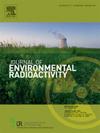Investigation of tritium content in wild plants growing in an area with an underground source of tritium
IF 1.9
3区 环境科学与生态学
Q3 ENVIRONMENTAL SCIENCES
引用次数: 0
Abstract
Within the framework of the presented work, the results of large-scale studies of the content of TFWT in wild plants growing in an area with an underground source of tritium are presented. Various types of plants were studied: herbaceous, shrubby, woody. The concentration of TFWT in various vegetative organs of the same plants was analyzed separately. Sampling was carried out throughout the growing season from germination to wilting of plants. Additionally, plants with aerial intake of tritium were studied.
The concentration of TFWT in the leaves of plants at the root pathway of tritium intake into plants is on average 0.71 of the concentration of TFWT in the stems of the same plants. This value varies from 0.30 ± 0.06 to 1.1 ± 0.3 for plants of different species, but never exceeds 1 significantly. The concentration of TFWT in the leaves of plants with an aerial intake of tritium is on average 1.5 times higher than the concentration of TFWT in the stems of the same plants. This value varies from 0.86 ± 0.59 to 2.9 ± 1.9, but never significantly below 1.
The concentration of TFWT in the same vegetative organs of herbaceous plants of different species growing on the same site differs significantly - up to 2.6 times. The concentration of TFWT in the vegetative organs of herbaceous and woody plants also differs significantly – up to 2.3 times.
The concentration of TFWT in the same vegetative organs of plants of different species can vary up to 3.5 times. At the same time, the concentration of TFWT in shrubby and woody plants does not differ so significantly – the average difference is 1.2 times, with the largest detected difference being 1.4 times. There is practically no significant difference between the content of TFWT in different types of woody and shrubby plants.
The dependence of the concentration of TFWT in the vegetative organs of plants of the same species at different vegetative stages was found. The concentration of TFWT in the same vegetative organ of a plant of the same species varies up to 14 times and, as a rule, decreases significantly by the end of the growing season.
Thus, it is proved that the distribution of tritium over the vegetative organs of wild plants is uneven. It depends on the mechanism of tritium intake into the plant, the type of plant, its vegetation phase. An innovative method is proposed for determining the mechanism of tritium intake into a plant by the coefficient M – the ratio of TFWT in leaves to TFWT in plant stems. At a value of the coefficient M below 1, the intake of tritium into vegetation is predominantly root, at a value above 1– it is aerial.
地下氚源区野生植物氚含量调查。
在提出的工作框架内,对生长在地下氚源地区的野生植物中TFWT含量的大规模研究结果进行了介绍。研究了不同类型的植物:草本、灌木、木本。分别分析了同一植物各营养器官中TFWT的浓度。取样是在整个生长季节进行的,从植物发芽到枯萎。此外,还研究了取食氚的植物。在氚进入植物的根通路上,植物叶片中TFWT的浓度平均为同一植物茎中TFWT浓度的0.71。不同种类植物的该值在0.30±0.06 ~ 1.1±0.3之间变化,但从未显著超过1。取食氚的植物叶片中TFWT的浓度平均比同一植物茎中TFWT的浓度高1.5倍。该值在0.86±0.59到2.9±1.9之间变化,但从未显著低于1。同一地点不同种类草本植物同一营养器官中TFWT浓度差异显著,可达2.6倍。草本植物和木本植物营养器官中TFWT的浓度也存在显著差异,最高可达2.3倍。不同种类植物同一营养器官中TFWT的浓度差异可达3.5倍。同时,灌丛和木本植物中TFWT的浓度差异不明显,平均差异为1.2倍,最大差异为1.4倍。不同类型木本和灌木植物中TFWT含量几乎没有显著差异。发现同种植物不同营养阶段营养器官中TFWT浓度的依赖性。同一种植物的同一营养器官中TFWT的浓度变化可达14倍,并且通常在生长季节结束时显着下降。由此证明,氚在野生植物营养器官中的分布是不均匀的。这取决于氚进入植物的机制,植物的类型,其生长阶段。本文提出了一种利用叶片中总掺水量与茎中总掺水量之比M系数来确定植物对氚的吸收机理的新方法。当系数M小于1时,植被对氚的吸收以根系为主,系数M大于1时,植被对氚的吸收以空中为主。
本文章由计算机程序翻译,如有差异,请以英文原文为准。
求助全文
约1分钟内获得全文
求助全文
来源期刊

Journal of environmental radioactivity
环境科学-环境科学
CiteScore
4.70
自引率
13.00%
发文量
209
审稿时长
73 days
期刊介绍:
The Journal of Environmental Radioactivity provides a coherent international forum for publication of original research or review papers on any aspect of the occurrence of radioactivity in natural systems.
Relevant subject areas range from applications of environmental radionuclides as mechanistic or timescale tracers of natural processes to assessments of the radioecological or radiological effects of ambient radioactivity. Papers deal with naturally occurring nuclides or with those created and released by man through nuclear weapons manufacture and testing, energy production, fuel-cycle technology, etc. Reports on radioactivity in the oceans, sediments, rivers, lakes, groundwaters, soils, atmosphere and all divisions of the biosphere are welcomed, but these should not simply be of a monitoring nature unless the data are particularly innovative.
 求助内容:
求助内容: 应助结果提醒方式:
应助结果提醒方式:


